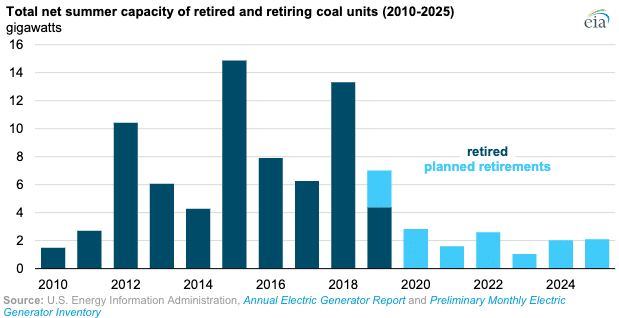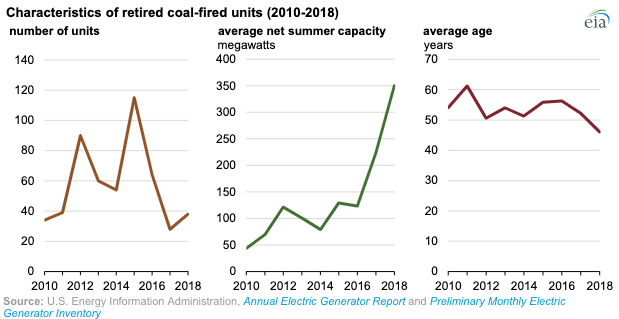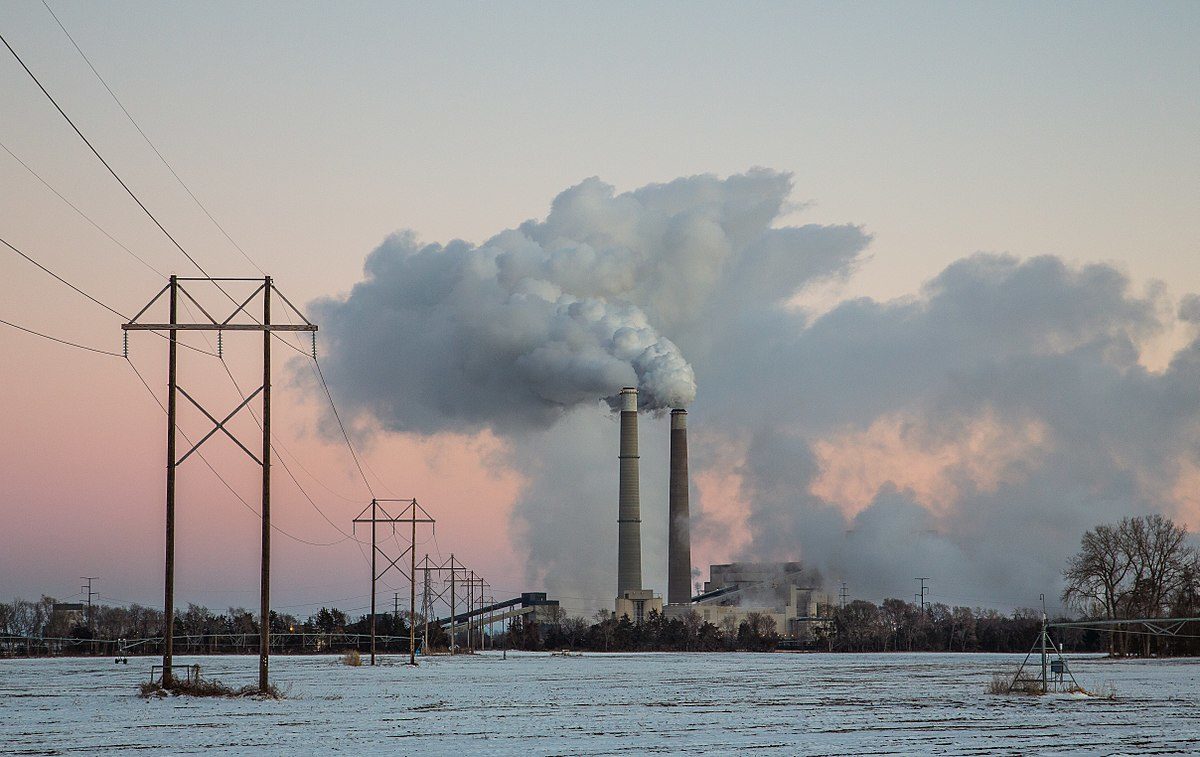The last decade has seen a dramatic change in the U.S. generation fleet, with hundreds of older coal-fired power plants being shut down, and replaced with at first gas plants, and increasingly wind and solar.
There are many reasons for this. The Sierra Club’s Beyond Coal campaign deserves credit, as does the Obama Administration’s mercury rule, which pushed older, dirtier plants into the red. But according to multiple studies, the chief cause of this was the shale boom and the inability of coal to compete with generation from cheap fracked gas.
Today the U.S. Department of Energy’s Energy Information Administration (EIA) released a new analysis which provides additional depth to the coal retirement story, which could suggest that the fall in coal is accelerating, which would create even more space for renewables.

It’s hard to draw too many conclusions from the overall capacity of coal plants that have retired, as the pattern is highly uneven from year to year. But of the 546 coal-fired power plants totaling over 102 GW which have gone offline during the last decade, the ones that have shut down in the last few years have been both younger and larger than previous plants.

According to EIA, The average age of coal plant that shut down in 2018 was 46 years – 10 years younger than the ones that shut down in 2015. Additionally, the average capacity of plants that are shutting down has nearly tripled, from around 100 MW in 2015 to 350 MW last year. And this means that it is not only small, ancient coal plants that are feeling the heat, but younger, bigger units, which have better economies of scale.
New wind & solar cheaper than existing coal
This phenomenon of younger and larger coal plants shutting down which was revealed by EIA is supported by a study which Energy Innovation released in March which showed that it would be cheaper to replace 74% of U.S. coal with new wind and solar. The study further found that wind and/or solar cost at least 25% less for a whopping 94 GW of existing plants.
One of the key advantages here that is overlooked in much of the media coverage of this report is that as coal plants shut down, the transmission infrastructure which was built to bring their power to market becomes available for other forms of generation – including new wind and solar projects.
This is also being validated by the decisions of some utilities, such as Northern Indiana Public Service Company (NIPSCO), which announced last September that it will shut down all of its coal generation by 2028, replacing these plants with solar, wind, demand response and spot market purchases.
The losing war to save coal
These findings stand in sharp contrast to a bill recently signed by Governor Mike DeWine (R) in Ohio, which will provide an estimated $900 million bailout for coal and nuclear power plants, largely to benefit bankrupt power company FirstEnergy Solutions but also Duke Energy and American Electric Power (AEP), which invested in two coal plants through the Ohio Valley Electric Corporation.
It also stands in sharp contrast to the long-term plans of Duke Energy, which plans to keep coal plants in Indiana online for decades. But like President Trump’s empty promises to coal miners, Duke, FirstEnergy, AEP and the DeWine Administration can’t stop the death of coal. Instead, they can only engage in cynical delays, as the economics become more and more forbidding.
This content is protected by copyright and may not be reused. If you want to cooperate with us and would like to reuse some of our content, please contact: editors@pv-magazine.com.









Good read.
The coal death spiral has begun. There have been 5 coal mining companies that have declared bankruptcy since October. Blackjewel can’t get funding to continue operations and is going to end up selling back it’s Wyoming mines to the previous owner (who also went bankrupt) because they are still on the hook for the reclamation and don’t want to do it.
How well do solar panels work under a foot of snow and endless cloudy days in the winter?
I know this isn’t the point, but I would like to suggest that instead of making ignorant, dismissive comments, you look up the average capacity factors for solar in different states. It’s on tab 14 of the spreadsheet. https://www.eia.gov/electricity/state/
Solar is hitting rooftops so fast, it’s a matter of time before most people will go that direction, especially as it continues to drop in price.
Duke has whored itself on the East coast for those ‘cheap’ fueled generation resources that other utilities are trying to ‘divest’ themselves of before calamity or environmental disaster forces the hand to be played. The West coast Duke is buying into ‘cheap’ solar PV farms developed by others, so that Duke can weasel its way into the ‘regulated monopoly’ of the regional utilities like SCE, SDG&E and PG&E who at this time is particularly vulnerable to take over from its past idiocies and failures to perform. Duke wants to stand in the middle of the teeter-totter and lean towards the flow of money. Sooner or later, this practice will come back to bite Duke hard and large.
At the end of the day it is about economics and not this save the earth rhetoric. Natural gas is so inexpensive and plentiful right now that coal is being replaced with gas. However, the environmentalists of the Democrat party will not be happy until all fossil fuels are replaced but that is impossible. Petrochemicals are needed for everything. What is being lost are good paying union jobs for coal miners, plant operators and railroad workers. They now vote Republican. The tragedy is that coal emissions can be sequestered underground and the Chinese will do it but America probably not. The Chinese just build while America goes to court.
That’s a lot of interesting & unsupported statements.
Coal is being partially replaced with gas, and partially with renewables. In fact, in all but one of the last three years more wind and solar capacity was added than gas capacity.
Per your claim that “petrochemicals are needed for everything”, I would encourage you to do some reading on integrating high levels of renewable energy, the electrification of transportation of transportation and biological sources of plastics. I think you will find that contrary to this claim, there really isn’t demand for much of any service that we can’t meet elsewhere.
Per your jobs claim: there are 240,000+ workers in solar making an average of $26 per hour, and it only supplied 2.3-2.4% of our electricity last year. The Energy Transition is the greatest job creation opportunity of our lifetimes. More of these jobs do need to be union, but I think that will come in time.
Also, railroad workers are in no danger (plans for decarbonization of transportation would involve more railroad workers, not less). Neither are plant operators (a really tiny portion of energy jobs), who are still needed on renewable energy plants.
Finally, per your claim that all of our emissions can be sequestered underground: Please provide a source for this rather unlikely claim.
As for the voting Republican, that’s a bigger issue; but by your logic, would all of the quarter-million solar workers vote Democrat? They don’t, and this should tell you something.